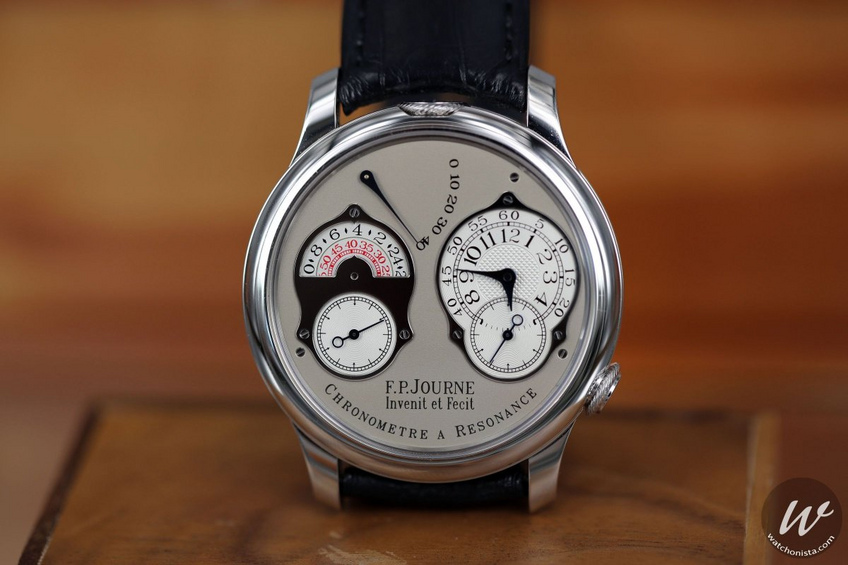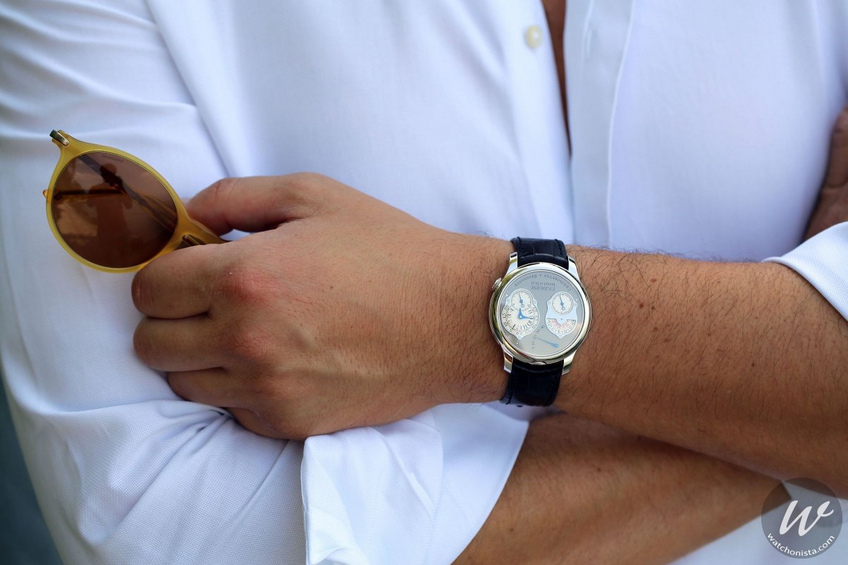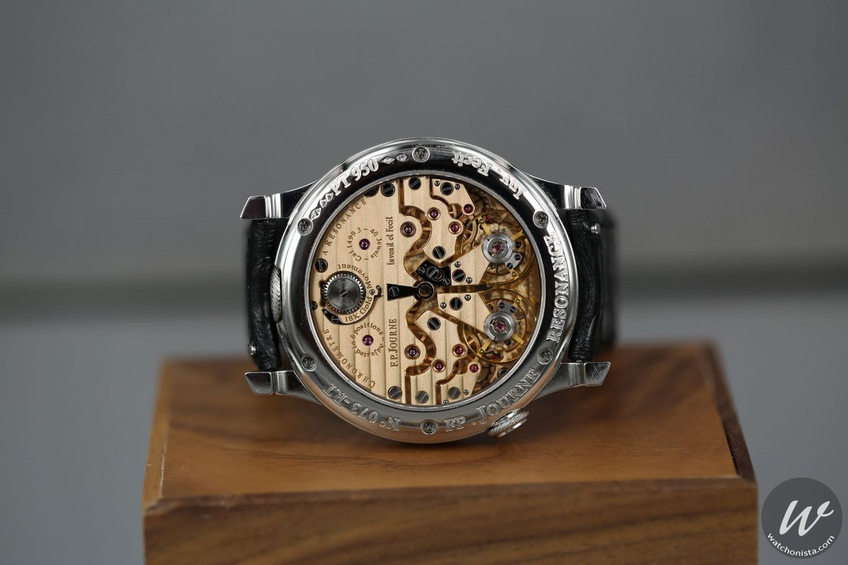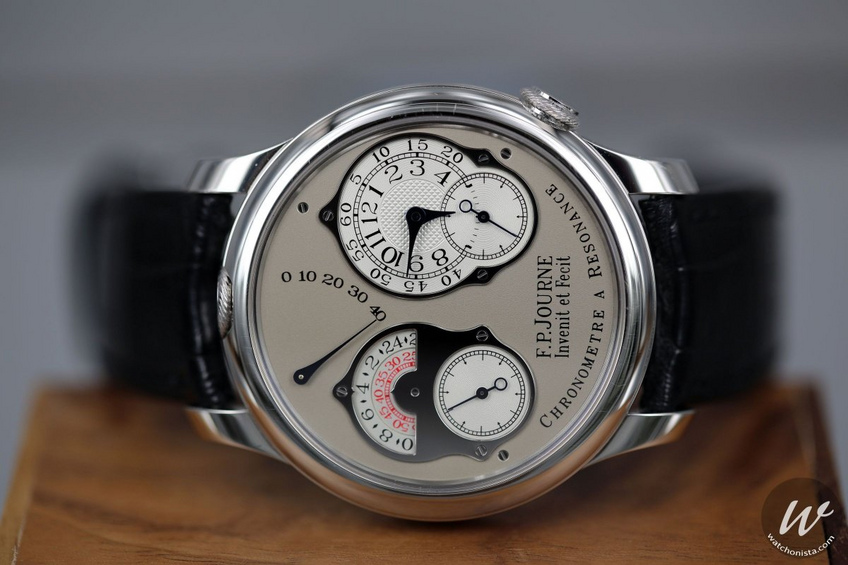

F.P. Journe: 15 years of good resonances
In 2000, François-Paul Journe introduced a revolutionary watch inspired by Antide Janvier's resonance regulator. This year, it has celebrated its 15 years of good waves.
Exactly 15 years ago, we were given the opportunity to perform a hands-on test on the first generation of resonance watches for a short time. The platinum piece, with outstanding design and functions, made quite an impression. At that time, its design was close to the first marine chronometers, some of which are still exhibited at “Arts et Métiers” in Paris or at the international Museum of La Chaux-de-Fonds. But, it is mostly the way in which it was designed that stirred. Of all the pieces available on the market, only this reference used the mechanic resonance principle to maintain the reference oscillation frequency, and thus contributing to improve the daily rate.

A scientific heart
This may seem complicated to novice technicians but in fact, the whole concept is easy to explain, even if it seems hard to comprehend. In a few words, the system, developed by Antide Janvier and taken over by François-Paul Journe, requires frequencies and resonance effects in the material in order to end with a dynamic pairing of the two oscillating balances at the same speed. To understand how this works, take two swings having the same weight, at a public garden for example, and throw them along the same axis with a time lag. One can easily observe that they stall at the same frequency, thus producing a synchronized swing.The ancients had perfectly understood this resonance effect and François-Paul Journe had the genius inspiration to adapt it to the wristwatch by embedding dual mechanic movements on the same plate with closely-fitted regulators. The purpose of the proximity of the two organs, oscillating at 3 Hertz (21'600 vibrations per hour) is to limit and smoothen the speed variations recorded by the balances from the wearer’s movements.
The effect obtained does not average the precision but enables to smooth and reduce the inertia effects on the balances, thus enabling the timepiece to have a precision close to a product that could remain static on a control bench.

An exceptional product
The tested piece is of course not from the first generation, and not even from the second one, which appeared in 2004, with a solid 18 carats gold caliber but has to do with the third generation that was launched in 2010, for the tenth anniversary of this unique time measuring instrument. It was so unique that it won a prize at the Grand Prix de l’Horlogerie de Genève (GPHG). The least that can be said is that the dial’s original design and the no match construction of the 40-mm “beast”, a very reasonable size (that exists in 38-mm version also), caused a stir. Unlike the past models, this version presents two display modes. The first sub-timer is equipped with a structure screwed in the dial that displays digital time by using disks and rotary bows. The minutes have been transferred in red on a white silver-plated background to make time reading easier. The second sub-timer has a more classic layout, inspired from yesteryear’s chronometers.

The art of equilibrium
It is to be noted that the direct-drive seconds-hands of uncommon dimensions grow away from each other. This elaborated structure is worked as would be a French garden. It is pure logic that this organ holds a place of honor as the complete symmetry in the round-minute is proof that the watch is perfectly set.As a guarantee of optimal setting, the crown located at 4 o’clock has to be pulled to bring back the two direct-drives to zero all at once and set off again.This whole piece is driven by an in-house manual winding mechanic caliber (reference Cal.: 1499.3), whose plate and bridges are made of solid 18 carats pink gold. The 32.6-mm caliber features a 40-hour power reserve (with a hand-indicator located at 12 o’clock), owns a distinctive symmetric architecture, just as for the dial. Nonetheless, the mirror-effect is not complete as the balance-cock on the right is equipped with a regulating screw, to set the caliber correctly. It also allows the watchmaker in charge of the setting to shift the regulating group, found at the right (seen from the back) in a micrometric way in order to succeed in putting the balances in tune.

Town traveler’s watch
This two-motion original piece has the opportunity to be used as a travelling watch as the two displays are independent from each other. In this way, the departure time zone will be saved on the left sub-timer while the local time will be simply set with the help of the winding crown located at 12 o’clock. This creation is available in 18 carats pink gold or in platinum and in 38-mm or 40-mm versions. It is attached with a leather strap or one made of the same metal used for the case. With an exceptional readability, the professionals recognize it as a reference. Its preciousness outshines the simple notions of aesthetics. The resonance watch, which celebrates its 15th anniversary this year, is part of the models that pure experts have to possess in their collection along, naturally, the great classics of reputed firms.















